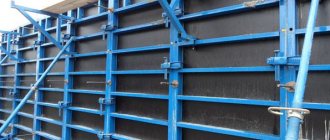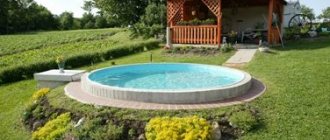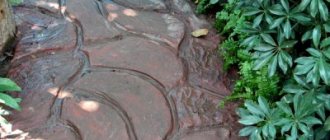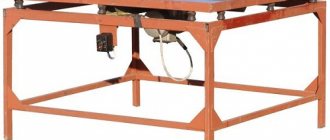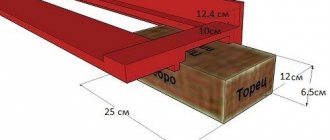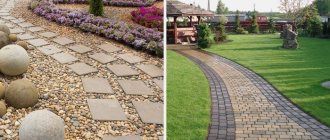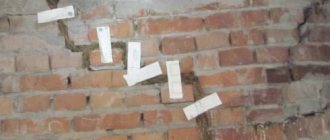Decorative cement balls for the cottage and garden: step-by-step master class, examples with photos, best ideas
First of all, you should take care of your safety: wear safety glasses, gloves (leather or rubber), and closed shoes. Prepare a hammer, paper, container. As for the shape, it can be made of glass, plastic, or use a children's rubber ball of a suitable size. Concrete must be prepared in the following ratio of components:
- cement - 1 part;
- sand - 2 parts;
- crushed stone - 3 parts.
First mix the dry ingredients and then dilute with water to form liquid sour cream.
DIY garden crafts can bring you great pleasure. Choose the figure that best suits your character and the design of your garden. Let's try to make garden figurines from cement with our own hands. The process, surprisingly, is not as complicated as it seems. But the result is truly surprising!
See what beautiful flower containers you can make from cement mortar and an old rag. This is truly crafts made from scrap materials!
To work, we need a cement solution - mix a thick solution of 1 part sand, 1 part cement.
We immerse a rope in the solution, it can also be strips from an old T-shirt, etc. We inflate the balloon and prepare a stand for it where it will dry. This could be a regular bucket. We wrap the ball with a rope in cement mortar.
After the solution has dried, use a needle to blow off the ball. All! Our garden art object is ready. Can be painted if desired.
Agree, it looks like dragon eggs)) We will make this from cement.
We take the same balloon and cover it with cement mortar. Here you can add a tablespoon of gypsum to the solution, but you need to work quickly.
After the solution has dried, remove the ball and paint the inside of the egg. You can use it as Easter decor in your country house by making a flower arrangement of primroses in it.
These cute garden gnomes are also very easy to make.
For the gnome we need cement, a metal rod, stocking and rope. We pour the cement solution into the stocking, and insert metal reinforcement into it for strength. By twisting the rope, we form noses and legs. Let's not forget about the beard - this is an additional piece of material under the gnome's nose. Hang the gnome by the top of the cap and leave to dry.
When the cement has dried, remove the gnome and polish the top with a more liquid solution of cement and gypsum. We are waiting for the gnome to dry and we can tint or paint it. Pretty guys, aren't they?
We will not talk about the principles of creating a fountain in the country. This is the topic of a separate article, and you can read about it in detail here. We will make leaves from cement.>We need a fairly large leaf, and with the help of cement, we form a copy of it.
After drying, the sheet can be worked out in more detail and painted.
And you will become, almost free of charge, the owner of such a beautiful fountain.
Are you not a sculptor at all? But believe me, you can make these creative flower containers.
We need a plastic container, foam plastic, reinforcing mesh. We make a cement solution by adding a spoonful of gypsum directly into the palm with the solution and thus form our “sculpture”
But not all of us are fans of modern abstract art. But you can easily make garden crafts in a classic style.
But, because You are not a sculptor yet, you need a template - it could very well be an old doll.
Because If this is not just a decorative garden figurine, but a flower bed in the shape of a girl’s head, then the top part needs to be cut off.
Then the head is painted. To add texture, the template is first painted with dark gray paint. Allow to dry and apply a layer of lighter paint. After drying, apply a layer of even lighter paint with light strokes.
This is a very simple process, and all the examples of this style that you see in the article were made by teenagers in a craft class.
For those who liked the process of making concrete crafts, we will also tell you a simply stunning technique for creating garden figurines.
Yes, we will need the old doll again!
First, we strengthen the doll using hot glue and a bamboo sushi stick on a heavy stand. By the way, we can also make it from cement. We cut out angel wings from foam plastic and attach them to the doll with hot glue. Let's give the doll a new dress and, with the help of strokes of hot glue, create a more interesting texture on the wings and hair.
We coat our template with a solution of cement and gypsum. Let's paint.
Now, with the help of old toys, you can make almost any garden figurine yourself.
Cat flower bed.
This cute flowerbed cat is made from a plastic bottle and cement. We will need: cement, sand, plaster, water, a large plastic bottle, wire, paint, wooden slats, varnish. The owner of this cat, Natasha Koneva, will tell us how to make such a funny figurine with her own hands. We cut off a plastic bottle - this container will be our flower garden.
To prevent the cement from slipping off the plastic, we tightly wrap it with wire. We knock down a wooden frame from slats. We attach our plastic container to it. Mix a cement mortar with the consistency of thick sour cream at the rate of 1 part sand, 1 part cement. We will add gypsum only to the finished portion that we have in our hand, because...
the solution with gypsum hardens instantly. We work in rubber gloves. Take a handful of solution in your hand and add a tablespoon of gypsum to it. Knead it in your hands, roll it into a sausage and attach it to the frame. So, step by step, we apply portions of the solution on top of each other, creating the necessary bulges and smoothing the surface.
We sculpt our cat’s face from small balls of solution in much the same way as we sculpted from plasticine in childhood. In order for small parts to hold better, before attaching them to the body, we lubricate the surface of the figurine with water. With a damp hand, we polish the surface of our garden figurine. To dry, cover the figurine with cellophane for 3-4 days.
On the first day, the figure must be periodically additionally moistened with water. After drying, sand the surface with sandpaper. You can paint such a figure with water-based paint, enamel, or car paints. After painting, coat the surface with varnish. For the winter, the garden figurine must be removed from the street, because... It may crack due to frost.
You might also want to get yourself such a wonderful cat. The great thing about cement figurines is that they are cheap to make compared to garden figurines made of metal or wood. You can start with simple garden crafts, which can be no less interesting than some particularly complex ones. You can combine cement with other materials. — for the face of this little garden fairy “Ladybug” we took the head of an old doll.
Plan in advance where to place the figures in the garden. This will make it easier for you to determine the exact size and color of the garden figurine.
We suggest you familiarize yourself with How to lay concrete
Decide what style your garden will be. No matter how beautiful your garden crafts are, they should be in the same style.
Don't overload your garden with crafts. A few simple but funny garden figurines in advantageous places in the garden will make a greater impression than an ill-conceived mass of the most wonderful and interesting garden crafts.
Coordinate the size of the figurine and the garden. Large open spaces require larger figures. And small garden figurines can be interestingly placed near tree trunks, near a small pond or fountain, along garden paths.
DIY garden crafts will add more interesting details to the overall look of your garden.
A variety of decorative elements can be used to decorate the landscape design of a site. They can be purchased at a specialty store or made yourself. An original option for the garden are decorative balls cast from cement.
In order to make a decorative craft in the shape of a ball, it is recommended to perform several procedures:
- Making a solution. One often takes one part of cement, two parts of sand and three parts of crushed stone. All components are mixed. After this, you need to add water to them and mix until you get the consistency of rich sour cream.
- Filling out the form. Plastic or glass molds can be used to make concrete decorative elements. But the best and most convenient option would be to use a rubber ball. A small hole is made in it through which the solution will be poured. Filling the ball should be gradual. After pouring part of the concrete mixture, it must be compacted. After this, another portion of cement is poured. The manipulation continues until the rubber ball is filled to the top. To ensure maximum strength of the concrete product, it is reinforced. In this case, a wire is inserted into the ball and bent in the form of a spiral. The surface on which the balls are made should not be hard. Otherwise, the product may become deformed.
- Removing formwork. After pouring the solution, you need to wait a few days for it to harden. After this time, you can begin removing the formwork. In this case, it is recommended to cut off the rubber in parts using a stationery knife. When using a glass or plastic mold, break it with a hammer.
- Cleaning. In order to ensure the smoothness of the surface of the ball, it is recommended to dip it in water. To avoid damage to the skin of the hands, it is recommended to carry out manipulations with gloves. If there are small pores on the product, they are covered with the remaining solution.
- Decor. For landscaping, you can use such a ball or decorate it. There is an opportunity to decorate it with acrylic paints. You can lay out a mosaic of tiles. It is also recommended to use broken dishes or glass, coins, mirrors. Due to the presence of a large number of options for decorating the ball, it is possible to choose the most appropriate option for landscape design in a particular case.
Creating a concrete ball is a labor-intensive but simple procedure that anyone can do.
Modern designs use interesting ideas to create concrete balls. In most cases, the creation is carried out:
- Openwork ball. To create the product, it is recommended to use a solution prepared from sand and cement in a 1:1 ratio. A rope or strips of fabric are dipped into the solution. Next, you need to inflate the balloon and prepare a stand for it. In most cases, an ordinary bucket is used. The ball is randomly wrapped with rope. After the solution has dried, use a needle to deflate the ball. If you want to create a romantic design, then it is recommended to install a lighting device inside the ball.
- Broken eggs-candlesticks. It is possible to create original balls in the form of broken eggs. The balloon is half-lubricated with the solution. In this case, it is necessary to ensure that the edges are uneven. After the solution dries, the ball deflates. The resulting form must be turned over and the lighting device installed in it.
- Flowerbed. Cement balls that are hollow can be used as flower beds. To make them, you need to take a ready-made cement mortar and apply it to the balloon. In this case, the edges should be smooth. Over the course of several days, it is necessary to periodically spray the solution to prevent it from drying out. It must be dried in shaded conditions. After a few days, it is recommended to reapply the solution and dry. Next, the ball must be turned over and painted in a bright color. It can also be decorated with broken glass, buttons, mirrors, shells, etc. Soil is poured into the resulting hole and flowers are planted.
Crafts for the garden: how to make a ball to decorate your garden - catalog of articles on the site
Balls are a fertile basis with which you can create incredibly interesting crafts for the garden. However, where can you get big balls?
The recommendations of foreign lovers of garden decor are not very suitable for us: most often they advise using old bowling balls. But that is abroad, where bowling has been a popular game for many decades. Indeed, some of the balls have become old and may well turn into garden decorations. But bowling came to us not so long ago, the balls have not yet worn out, and new ones are so expensive that you won’t buy them for crafts. What options do our summer residents have? As always, make balls from scrap materials.
In fact, the ball, like other garden crafts, can be made from any material, even not very moisture-resistant. Since you can always protect the surface (well, and the “insides”, respectively) with moisture-resistant means. For example, plaster with a thin layer of facade plaster, use putty with the same properties, coat with varnish for external work, etc.
Styrofoam ball
Firstly, you can buy a foam ball - today many people make crafts for the garden and home, which is why they offer different types of blanks. The only thing is that it is not easy to find foam balls of especially large sizes on sale. Solution: call companies and workshops that make blanks and place an order.
How to make a large foam ball yourself
You can make a large foam ball. Finding a piece of foam plastic large enough to cut out a ball for decorating an area is difficult. But polystyrene foam is a material that is easy to cut, even with a simple knife. Therefore, you just need to glue several pieces of sheet foam together, and only then cut out the ball. Then level it with a knife, sand it, and apply façade putty to the surface. After the spherical base of the garden craft has dried, you can begin decorating it.
Cement ball
In principle, there is nothing complicated: find a hollow mold, fill it with mortar, wait for the mortar inside to harden, and release the concrete ball from the mold. The shape could be, for example, a children's ball. If you don’t have a ball or you need a ball of large diameter, you can make a base of two hemispheres by pouring the solution into two identical bowls, and then connect the hemispheres with the same solution.
Everything is fine, but such a ball, of course, will turn out to be very heavy. You can make it easier. After all, you can always add a light filler to the solution. And it is not necessary to extract perlite or vermiculite for this; you can add peat to the solution. By the way, garden crafts made from cement with the addition of peat will look very natural: the peat is washed away from the surface over time, and the ball looks like it is made of old stone.
Forming a ball of cement using pouring can be problematic for some. In this case, you can make a ball in a different way. It's generally lightweight.
We take a ball shape that we don’t mind (an old children’s ball or two old bowls fastened together). We make a cement mortar (with or without additives that will lighten the weight) and coat the form in layers. To prevent the solution from slipping, you just need to wrap the form with some kind of twine. When the solution dries, the shape will remain inside it, but you will have a wonderful base for a garden craft.
Now let's get down to the most important and interesting thing: decorating. The balls can be painted in any color, it is only important that the paint is for external (facade) work. Balls painted with mirror paint look fantastic. You can even decorate such garden crafts with decoupage, but, again, choose a varnish for fixing and protecting the design for the outdoors (yacht, for example).
I want more articles:
Leave your review
Average rating: 0 reviews
Tags:
cement figure mortar
www.domstoy.ru
Our common house in the shape of a ball
The earth, our common home, also has the shape of a sphere. A drop of water has an oval shape. Pointed mountains eventually turn into gentle, rounded hills. In nature, everything strives for smoothing and leveling.
So why are most of our houses angular and not round? There are several reasons for this:
- Our traditions and habits
- Difficult to apply rectangular doors and windows
- There are no straight or vertical walls except internal ones
- Lack of necessary materials and technologies
Our traditions determine both our way of life and the appearance of our traditional home. We are used to living in square and rectangular houses and apartments. We are used to seeing vertical and straight walls.
Furniture is placed along the walls. In a round house where to put it? Beds are placed against the wall. How to hang a shelf on a round wall?
What are houses made of? Made from oblong and straight materials. We're so used to it. That's why the houses look rectangular. Recently, technologies for monolithic housing construction have appeared. It would seem that you can build a round house.
But the forms into which concrete is poured are also straight! You can also make an oval shape, but it is more difficult. Yes, and all this is unusual. How to insulate these oval walls? We don't yet have round insulation. In addition, it must also withstand moisture. After all, you will have to insulate from the outside.
So is the game worth the candle? Are the advantages of a round ball house really that great? Great or not, everyone decides for themselves. But, undoubtedly, they exist:
- No need to build a roof
- The volume of the house is fully used
- Less material consumption
- Less heat loss
A house in the shape of a ball does not have a roof as such. But this is a significant cost item during construction. The walls blend smoothly into the ceiling. Actually, there is neither one nor the other here. Is not it?
The round house has neither an attic nor a basement. Therefore, the entire volume of the house is used more rationally.
For the same reasons, the consumption of materials is significantly less. It actually produces more waste. After all, construction materials are oblong, not round.
We invite you to read about candied honey: what to do if the honey is candied, how to make it liquid
Heat losses are less than those of a traditionally built house because the surface of the walls of the sphere is smaller than the surface of the walls of a conventional dwelling with the same internal volume.
Filling out the form
Pour sand and make a depression in it, place the ball in the resulting “pillow”.
Please note that even thick glass can crack or break under the weight of a heavy concrete mixture. Therefore, rubber balls are more convenient to use. You need to make a small hole in them through which you can pour the resulting solution. Fill the ball gradually in parts, compacting the contents after each placement by tapping on the table or kneading the product.
Pay attention to the surface on which the products will be placed. It should not be hard so that the ball does not lose its round shape. We recommend using a sand cushion. Once you have placed the concrete balls on the pad, add some more material on top, giving them a perfect spherical shape. The hardening time of the ball is from 1 to 2 days.
Manufacturing technology
The algorithm of actions is simple and accessible to everyone. Depending on the chosen model of the ball and the frame on which the cement mixture is applied, the time for creating a landscape masterpiece also varies. The variety of methods and types of base used allows every design lover to choose the best option that will satisfy the aesthetic needs and financial capabilities of the owner of a personal plot.
Formwork and form
Concrete balls are formed on the basis of the following frames:
- rubber balls - small ones for a cast ball, and large ones for creating hollow forms, but using a reinforced mesh;
- balloons and rope;
- plastic blanks that can be purchased at hardware stores;
- metal frame made of reinforcement.
Ball-shaped house
Despite the difficulties in construction, round houses are built even on an industrial scale. For example, in the Netherlands they built an entire block of round houses. Each such ball house is a separate dwelling for one or two people.
On the ground floor there are auxiliary rooms such as a bathroom or shower, and an entrance hall. On the second floor there is a living room. The windows in these houses resemble airplane windows. The walls of the ball are made of concrete.
And some eccentrics don’t build houses from anything. They use wood, plastic, concrete. And they turn out to be original houses. Quite beautiful.
Ball-shaped buildings
Not only houses are built in the shape of a ball. Various auxiliary structures sometimes have a similar shape. Like this gazebo for example. Very original. And transparent walls create a feeling of closeness to nature.
But this incomprehensible structure in the shape of a ball, the height of a five-story building, is located in the forest in the vicinity of the city of Dubna. Apparently, it was built for some scientific or military purpose, but today it is abandoned and no one needs it.
Anyone can build a ball house with their own hands. There would be desire and interest. And a house in the shape of a ball is already interesting in our world of rectangular buildings.
Garden fountain with leaves
We will not talk about the principles of creating a fountain in the country. This is a topic for a separate article. We will make leaves from cement.
We need a fairly large sheet, and with the help of cement, we form a copy of it.
After drying, the sheet can be worked out in more detail and painted.
We invite you to familiarize yourself with DIY New Year's toys: 50 options with photos on how to make toys for the Christmas tree
And you will become, almost free of charge, the owner of such a beautiful fountain.
Decoration
You can leave the finished ball as it is, or you can add a little of your imagination. Anything can be used: acrylic paints, tile mosaics, broken glass, mirrors and dishes, coins and even moss. There are a limitless number of options here, everyone can choose what they like and make a real work of art with their own hands. Ideally, the ball should be primed before painting. If you like the color gray, you can use a knife or screwdriver to cut out an unusual pattern.
How to decorate a product in an original way
You can decorate concrete balls in a variety of ways - with whatever is at hand: painting, mosaics, creating figures and original statues, etc.
- The simplest option is to paint it in a specific color. Ideas can be implemented in two ways: by adding pigment to a still liquid solution at the mixing stage, or by coating the finished product with special paint (which will also act as additional protection for the product from external negative factors).
- Cutting out ornaments and patterns around the circumference is done with a special tool or any suitable one.
- Gluing mirror glass, pebbles, old coins and any other small objects - such decor can be made either in the form of a mosaic pattern or involve a chaotic placement of parts.
You can try to initially implement an original idea - make not just a concrete ball, but an openwork product, an outdoor candlestick for atmosphere, a special flower bed, etc. Doing everything yourself is not very difficult.
An openwork ball is made from a solution of sand and cement in equal proportions. Strips of fabric or rope are dipped into the mixture, then an ordinary balloon is inflated, a stand is made for it (a bucket will do), and the balloon is wrapped randomly with a rope soaked in concrete. After the solution has dried, pierce the ball with a needle and remove it.
Broken eggs-candlesticks look beautiful - the balloon is covered with the solution up to about half, forming original uneven edges. Then the ball is deflated, the shape is turned over, decorated, and a candle or lighting fixture is placed inside.
This decor is often found in cafes and restaurants. You can buy them in Moscow and the regions, but it’s much cheaper and easier to make them yourself.
Empty cement balls can be used as a flower bed. To create the product, they take ordinary cement mortar and apply it to the same balloon, but the edges are formed even and smooth. A few days after the solution has dried, another layer of the mixture is applied and dried again. Then the ball is turned over, painted and decorated, soil is poured inside and flowers are planted.
Concrete balls are a functional and original option for decorating and zoning both home and public areas. Due to their strength and durability, the products are widely used for a variety of purposes. Many factories are engaged in the production of balls, but if you want to create an exclusive product, all stages of the work can be carried out independently.
Do-it-yourself garden figures made of concrete (photo): step-by-step instructions
We decorate the garden with concrete products
Concrete garden figures are an excellent solution for decorating your garden with your own hands. Concrete combines two main components, without which independent production of “sculptures” is simply impossible – accessibility and ease of use.
To such advantages we can safely add low cost and durability. Our publication contains a selection of the most interesting projects that you can actually bring to life on your own.
The content of the article
Concrete figures for the garden have long been an excellent embodiment of the creative ideas of landscape designers, and ordinary owners of garden plots. There is nothing complicated in making them. To prove this statement, we will provide you with a photo selection of finished products.
The main secret that such concrete figures conceal is the unique formwork form. After all, concrete is a very flexible material in all respects - whatever shape you pour it into, the product you get will be the same.
Craftsmen who make figurines with their own hands, not only for themselves, but also for sale, use special silicone or polyurethane collapsible molds, as in the photo below.
Silicone molds
If you have the opportunity to purchase such a silicone miracle, then do not hesitate and take it. And the video in this article will help you figure out how to use it.
But the price for such formwork is decent. In order to reduce the cost of concrete work as much as possible, we offer you simple master classes, where ordinary objects that surround us all the time are taken as a basis.
Garden figures made of concrete or plaster are becoming increasingly popular today. Every owner of a summer cottage or a country mansion can become a sculptor and designer, just awaken this talent in yourself.
Today, most parks and gardens are decorated with plaster or concrete sculptures. Concrete crafts are installed both in the center of the site and in secluded quiet corners. There are many companies that can make any sculpture for you to order or sell a finished sample. However, it is always much more interesting to make garden sculptures from concrete with your own hands, putting creativity and a piece of your soul into them.
These works do not require large financial investments; they can be made from cement or gypsum. Their distinctive feature is durability. You can give the products a wide variety of shapes and colors.
Contents of the material
Before you start making garden figurines, you need to accurately determine its purpose. This point is very important, since it determines what materials will be required to complete the sculpture.
So, to make concrete products with your own hands, you will need:
- Aluminum wire for making the frame of the future product.
- Concrete mortar or a mixture of water, sand and cement at the rate of three parts cement and one part sand.
- To increase the plasticity of the solution, you can add PVA glue to it.
- You can increase the moisture resistance of the solution using liquid nails.
- Putty knife.
- Polyethylene film.
- A small spray bottle filled with clean water.
- Plastic basin.
It is better to prepare all materials in advance.
To prepare a concrete solution, take 3 parts of cement and mix with 1 part of sand. All this is thoroughly mixed and water is gradually poured into the resulting mixture in small portions. The amount of water should be 2 times less than the amount of cement. You can knead the solution in the same way as kneading dough. As mentioned above, you can add liquid nails and PVA glue to the mixture to improve the quality and longevity of the product.
Concrete is a material that is quite easy to work with. You can create any shapes and figures. And even if you have never worked with concrete, the ideas presented in our article can be tried by a beginner. We are talking about various cement crops. We have prepared several master classes for you: how to make a concrete fountain, an unusual flower pot, cement benches, a bird bath, a garden path, and not only photo instructions, but also videos to help!
three convenient ways.
ESSENCE OF THE WORK
to create a ball of thread it looks like this... We wrap a small balloon with thread soaked in glue... And when the glue cocoon of thread dries, we burst the ball, take out its fragments from the cocoon, and get an openwork ball of thread.
Adhesive solutions can be different:
You can dilute WALLPAPER glue (paste based on starch)... or dilute and cook the starch with water yourself.
You can use SILICATE glue (Soviet transparent for paper)
You can use PVA GLUE in its pure form... or in a diluted form - then add water and sugar to it.
And the ways in which the work is done can be different:
METHOD ONE – through the bottle.
For convenience, it is recommended to thread the thread into a needle... use the needle to pierce the bottle with silicone glue through (enlarge it, pick out the hole so that the thread passes freely through the bottle)... This way we get a “mini-device” for wetting the thread with glue without dirtying the table.
METHOD TWO
– put a skein of thread in a bowl of glue – as in the left photo below... if you don’t want to spoil the whole ball (because it’s too big) – then you can pass the thread through the bowl of glue by hand (as in the right photo)
WITH WHAT TENSION TO WIND THE THREAD.
The thread on the ball should not be wound very tightly - so that the ball does not tighten and is not compressed by the thread. Otherwise we will get a crooked product.
HOW TO REMOVE THE BALL CORRECTLY.
It is best to dry the glue ball for 2-3 days. So that it hardens properly. If you start removing the ball before it has completely dried, you may end up with a wrinkled product.
Before bursting the ball, you need to make sure that it easily moves away from the walls of the thread cocoon. To do this, you can use the blunt end of a pencil to gently press on the ball THROUGH THE HOLES BETWEEN THE THREADS - in different sides of the ball - push the ball with a pencil so that it comes off everywhere from the walls of the cocoon.
After this, we burst the ball and pull out the burst rag by the tail.
AND ALSO... you can add a cocoon-web LACE.
But this technique can be supplemented with elements of a knitted applique from the same threads
... For example, you can make a piece of a knitted pattern in advance (as in the photo below) ...
To do this, first crochet the pattern element
(this can be a pattern for any crocheted napkin)… a small element, only the first few rows of the pattern… Glue this lace knitted circle to the surface of the ball. Drying...
Then we shave the end of the glue thread - and thread it into the NEEDLE
. And with such a thread and needle we begin to carefully (so as not to pierce) wrap the ball, and pick up (as we wind) the edges of the lace applique... and we get a cocoon into which a crocheted lace detail is sewn. Like in the photo below.
Or you can do it differently - IT’S EVEN EASIER TO DO
- wrap the ball with threads... dry...
- WITHOUT removing the balloon with scissors, cut a round hole (the size of your knitted applique) and apply glue to this head area on the balloon...
- soak the knitted applique with glue and attach it to the ball (so that its edges touch the edges of the web). When all this is dry you can remove the ball.
Openwork BALLS made of wire.
Using the same principle, ball-windings are made from wire. You just need to do it carefully so that the end of the wire does not cut into the ball and so that the wire itself does not cut the ball..
Here are some ideas on how to make a ball of thread yourself. As you can see, everything is quick and simple. Even a child can easily master the whole process.
Happy crafting!
Olga Klishevskaya, especially for the site “”
If you like our site,
you can support the enthusiasm of those who work for you. Happy New Year to the author of this article, Olga Klishevskaya.
Yulia Zhidovich
Comfort in the home is an important component of everyday life. A warm atmosphere is often created by small and inconspicuous at first glance details, which together give that long-awaited feeling of comfort. And you create comfort in the home with your own hands. You can, of course, use the services of a designer. Or you can create an interesting design using the things you have at hand: glue and thread, giving an original color to the interior of your home. Once you learn how to make a thread ball, it's not difficult.
